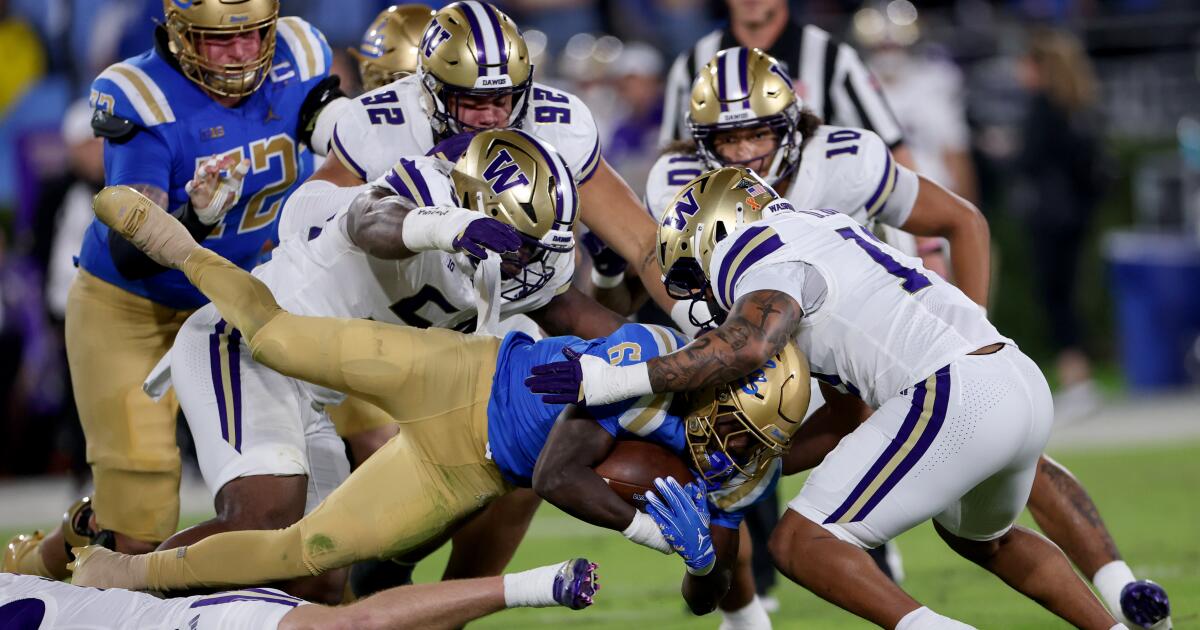Culture
New NFL kickoff rules could bring excitement … and chaos: 'It's going to be a s— show'

The NFL’s new kickoff rules are expected to revive one of the most exciting plays in the game while decreasing the risk of injury with fewer high-speed collisions. The plan is for the XFL-style setup to open up possibilities for return men.
Unless it doesn’t.
One factor that could limit what return teams do is the NFL allowing the coverage unit to begin its pursuit when the ball hits the ground or when the returner touches the ball (like in the XFL). The XFL had too many false starts and misjudgments of when the ball was possessed. The coverage team would try to time its start with when the returner picked up the ball, but it often jumped early, disrupting the game flow.
“The rules basically incentivize you to kick the … weirdest, s—tiest kicks you can kick,” one NFL special teams coach told The Athletic. “Any ball that can hit the ground is now artificial hangtime. And so the rules are incentivizing variations of squibs and wild kicks. And it’s going to be a s— show.”
GO DEEPER
Making sense of NFL’s new kickoff rule and what it means for next season
Part of the reason for the major changes in kickoffs was to make the play a spectacle again, but if teams can consistently get the ball on the ground and muck up the play, the league may consider adjusting this rule. In practice, teams have found that when the ball hits the ground, it’s nearly impossible to block anyone.
This is partially why the Kansas City Chiefs are experimenting with former rugby star Louis Rees-Zammit and safety Justin Reid as kickers. The kicks don’t have to be high quality, and a bad one that lands in the proper zone can create this artificial hangtime.
(Drew Jordan / The Athletic)
The other reason is that kickers are more involved in tackles. Longtime Chiefs special teams coordinator Dave Toub estimated that XFL kickers were involved in 25 to 40 percent of tackles on kickoffs — even if they weren’t making the tackles themselves, they had to do their part in making the returner change direction. Considering how valuable a good kicker is, special teams coaches may want to keep them out of harm’s way.
There was some creativity with return teams in the XFL, but a majority were vanilla and there weren’t a lot of big returns. Adding a second returner and having better-quality players to work with could open up the possibility for more creativity. But there’s a chance that once the new rules are being used, there won’t be much willingness to deviate from regular returns. Special teams coaches are conservative by nature because their units’ blunders are often magnified.
Despite the potential for the new rules to be a dud, there’s still plenty to be optimistic about because coaches used OTAs and will use training camp to find the best strategies. While some teams may want to play it safe, plenty will be trying to find advantages.
Teams know the new rules can open up a world of strategy. Special teams coaches will keep working on it into the season, but one thing is for sure: everyone is still learning. After OTAs, teams know more, but the experimenting and information-gathering process is ongoing.
“The team that figures it out kickoff-wise and kickoff return-wise is going to excel early,” Toub said in May. “We want to be that team.”
Free, daily NFL updates direct to your inbox. Sign up
Free, daily NFL updates direct to your inbox. Sign up
Buy
The Chiefs embrace outside-the-box thinking under head coach Andy Reid, which is why it was interesting that they signed Rees-Zammit. Toub said they’ve tried Rees-Zammit out as both a kicker and returner.
The new kickoff format requires a different type of returner. Returners typically have been small, shifty and good in open space. Now, with every member of the coverage unit on one line, more running back body types will be returning the ball. New returners will have to be able to get upfield, break arm tackles and get through the first level, like they would when running through an offensive line. Also, since the NFL will allow two returners rather than one as the XFL did, the returner who doesn’t get the ball must be a good blocker.
The Rees-Zammit signing got me thinking about whether some rugby strategy can be applied to the new kickoff return. I reached out to some rugby coaches and an NFL special teams coordinator to see if some of these ideas are feasible. I spoke to Golden State Retrievers head coach Kelly Griffin, former U.S. national rugby team head coach Gary Gold and former English rugby star Mike Tindall.
The new kickoff format gives the returner more space because the kickoff team can’t start until the ball is caught or hits the ground. So there’s a buffer for some creative actions with the returners initially.
One interesting idea that came up was using what is called a switch.
😍 Not much better than when a classic switch play comes off!pic.twitter.com/8EtuOuuE8k
— Planet Rugby (@PlanetRugby) January 11, 2024
Griffin drew up a play in which the return team would leave one of the inside coverage team players unblocked, have the returner draw him in one direction and then execute the switch. It would resemble a hook-and-ladder play in football.
(Drew Jordan / The Athletic)
The first XFL touchdown return was essentially a switch, but if you leave one coverage player unblocked like in Griffin’s design, you can get a double team at the point of attack or a blocker on the kicker. Also, this could be easier to execute with a second returner because he would be closer to the returner catching the ball and might even be able to get in position for an option-style pitch.
An NFL special teams coach I talked to thought throwbacks would be much more prevalent.
“I like throwbacks because they’re very low-risk,” he said. “So I feel like you’ll see more throwbacks this year than the last 20 years combined.”
It’s time for the 𝕎𝕖𝕖𝕜 𝟙𝟚 ℙ𝕝𝕒𝕪 𝕠𝕗 𝕥𝕙𝕖 𝕎𝕖𝕖𝕜.
We give you @UMichFootball‘s @mikebarrett_MB1-to-@AJHenning3 trick play kick return TD. 💥
📍 @OldTrapper pic.twitter.com/91rqNCfqgm
— Big Ten Network (@BigTenNetwork) November 21, 2021
There will be more distance for the returners to recover if there is a botched execution on a throwback, but the blockers up front will have more chaotic jobs because once the coverage team starts, there are only about 5 yards between them. There isn’t much time to pass off twists and switch releases.
“Every time we practice, we learn something new,” Toub said. “I draw up a play and it looks great on paper — and you can’t do it. You can’t get to certain blocks you think you can get to, so you throw it out. And it’s (on to) the next thing.”
One coach compared trying to block the coverage team to trying to cover receivers in the low red zone where teams play a lot of man and have to have techniques or systems to pass off switch releases.
The blocking up front will be key to whether teams can get creative on the back end. Still, the idea of leaving one man free for a potential lateral or option pitch is interesting if the returners can get in position and everyone else can be reasonably blocked.
A positive is that teams have gotten a good number of repetitions in practice because of the low impact and shorter distance players now have to run on kickoffs. The special teams staffs that come up with the most effective ways to kick the ball, cover, block and return will have big advantages over teams that lag behind. The learning process will surely extend throughout the season as well.
(Top illustration: Dan Goldfarb / The Athletic; photos: Dan Mullan / The RFU Collection and Justin Tafoya / Getty Images)

Culture
Do You Recognize These Past Winners of the National Book Award?

Welcome to Lit Trivia, the Book Review’s regular quiz about books, authors and literary culture. In honor of the National Book Awards presented by the National Book Association on Nov. 19, this week’s challenge celebrates winners from the past 20 years and asks you to identify a title by a short description of the work. In the five multiple-choice questions below, tap or click on the answer you think is correct. After the last question, you’ll find links to the books if you’d like to do further reading.
Culture
Video: ‘Flesh’ by David Szalay Wins 2025 Booker Prize

new video loaded: ‘Flesh’ by David Szalay Wins 2025 Booker Prize
transcript
transcript
‘Flesh’ by David Szalay Wins 2025 Booker Prize
David Szalay became the first British Hungarian to win the prestigious Booker Prize for his novel “Flesh.”
-
“I think fiction can take risks. I think it’s one of the things that it can do. It can take aesthetic risks, formal risks, perhaps even moral risks, which many other forms, narrative forms, can’t quite do to the same extent.” “I think all six of the books in the short list really, you know, not — it’s not saying this is the headline theme, but there is that theme of reaching out, wanting a connection.”

By Shawn Paik
November 11, 2025
Culture
Test Yourself on the Settings Mentioned in These Novels About Road Trips

A strong sense of place can deeply influence a story, and in some cases, the setting can even feel like a character itself. This week’s literary geography quiz highlights the starting points or destinations of five novels about road trips. (Even if you aren’t familiar with the book, most questions offer an additional hint about the location.) To play, just make your selection in the multiple-choice list and the correct answer will be revealed. At the end of the quiz, you’ll find links to the books if you’d like to do further reading.
-
Business6 days ago
Fire survivors can use this new portal to rebuild faster and save money
-

 World5 days ago
World5 days agoFrance and Germany support simplification push for digital rules
-

 News5 days ago
News5 days agoCourt documents shed light on Indiana shooting that sparked stand-your-ground debate
-

 World1 week ago
World1 week ago2% of Russian global oil supply affected following Ukrainian attack
-

 World5 days ago
World5 days agoCalls for answers grow over Canada’s interrogation of Israel critic
-

 World5 days ago
World5 days agoSinclair Snaps Up 8% Stake in Scripps in Advance of Potential Merger
-
Business5 days ago
Amazon’s Zoox offers free robotaxi rides in San Francisco
-

 Politics5 days ago
Politics5 days agoDuckworth fires staffer who claimed to be attorney for detained illegal immigrant with criminal history























